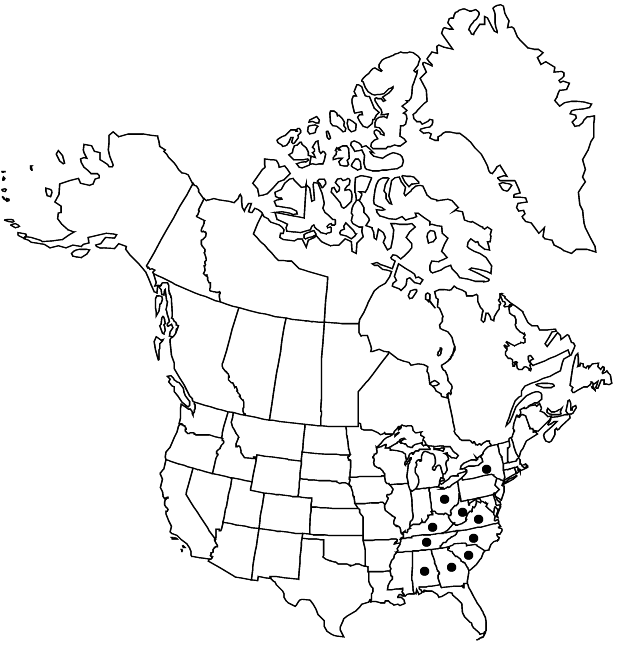Difference between revisions of "Eubotrys recurva"
in N. L. Britton and A. Brown, Ill. Fl. N. U.S. ed. 2, 2: 688. 1913 ,.
FNA>Volume Importer |
imported>Volume Importer |
||
| (6 intermediate revisions by 2 users not shown) | |||
| Line 1: | Line 1: | ||
{{Treatment/ID | {{Treatment/ID | ||
|accepted_name=Eubotrys recurva | |accepted_name=Eubotrys recurva | ||
| − | |accepted_authority=(Buckley) Britton | + | |accepted_authority=(Buckley) Britton |
|publications={{Treatment/Publication | |publications={{Treatment/Publication | ||
|title=in N. L. Britton and A. Brown, Ill. Fl. N. U.S. ed. | |title=in N. L. Britton and A. Brown, Ill. Fl. N. U.S. ed. | ||
| Line 7: | Line 7: | ||
}} | }} | ||
|common_names=Deciduous mountain fetterbush;red-twig doghobble | |common_names=Deciduous mountain fetterbush;red-twig doghobble | ||
| − | |basionyms={{Treatment/ID/ | + | |special_status={{Treatment/ID/Special_status |
| + | |code=E | ||
| + | |label=Endemic | ||
| + | }} | ||
| + | |basionyms={{Treatment/ID/Basionym | ||
|name=Andromeda recurva | |name=Andromeda recurva | ||
|authority=Buckley | |authority=Buckley | ||
| + | |rank=species | ||
| + | |publication_title=Amer. J. Sci. Arts | ||
| + | |publication_place=45: 172. 1843 | ||
}} | }} | ||
|synonyms={{Treatment/ID/Synonym | |synonyms={{Treatment/ID/Synonym | ||
|name=Leucothoë recurva | |name=Leucothoë recurva | ||
|authority=(Buckley) A. Gray | |authority=(Buckley) A. Gray | ||
| + | |rank=species | ||
}} | }} | ||
|hierarchy=Ericaceae;Ericaceae subfam. Vaccinioideae;Eubotrys;Eubotrys recurva | |hierarchy=Ericaceae;Ericaceae subfam. Vaccinioideae;Eubotrys;Eubotrys recurva | ||
| Line 29: | Line 37: | ||
|elevation=100-1200(-1500) m | |elevation=100-1200(-1500) m | ||
|distribution=Ala.;Ga.;Ky.;N.Y.;N.C.;Ohio;S.C.;Tenn.;Va.;W.Va. | |distribution=Ala.;Ga.;Ky.;N.Y.;N.C.;Ohio;S.C.;Tenn.;Va.;W.Va. | ||
| − | |discussion=<p>The occurrence of Eubotrys recurva in New York state, in mixed oak woods on Long Island, may represent naturalized plants, rather than a native population. Records from Ohio may also represent escaped plants.</p> | + | |discussion=<p>The occurrence of <i>Eubotrys recurva</i> in New York state, in mixed oak woods on Long Island, may represent naturalized plants, rather than a native population. Records from Ohio may also represent escaped plants.</p> |
|tables= | |tables= | ||
|references= | |references= | ||
| Line 38: | Line 46: | ||
-->{{#Taxon: | -->{{#Taxon: | ||
name=Eubotrys recurva | name=Eubotrys recurva | ||
| − | + | |authority=(Buckley) Britton | |
| − | |authority=(Buckley) Britton | ||
|rank=species | |rank=species | ||
|parent rank=genus | |parent rank=genus | ||
| Line 52: | Line 59: | ||
|publication title=in N. L. Britton and A. Brown, Ill. Fl. N. U.S. ed. | |publication title=in N. L. Britton and A. Brown, Ill. Fl. N. U.S. ed. | ||
|publication year= | |publication year= | ||
| − | |special status= | + | |special status=Endemic |
| − | |source xml=https:// | + | |source xml=https://bitbucket.org/aafc-mbb/fna-data-curation/src/2e0870ddd59836b60bcf96646a41e87ea5a5943a/coarse_grained_fna_xml/V8/V8_998.xml |
|subfamily=Ericaceae subfam. Vaccinioideae | |subfamily=Ericaceae subfam. Vaccinioideae | ||
|genus=Eubotrys | |genus=Eubotrys | ||
Latest revision as of 22:47, 5 November 2020
Stems erect, 1–4 m, branches spreading. Leaves: petiole 1–3 mm; blade 3–8 cm, surfaces pilose on major veins abaxially. Inflorescences spreading or ascending, secund, curved or recurved, 5–12 cm; bracts ± deciduous, ovate-deltate, 1–1.7 mm. Flowers: calyx campanulate, sepals ovate, 2.5–3 mm, apex acute; corolla white to pale pink, 7–9 mm, lobes recurved, glabrous; stamens 3–4 mm; anthers 2-awned, ca. 1.5 mm, thecae divergent distally; ovary glabrous. Capsules 3–5 mm wide. Seeds winged, oblanceoloid, flat, 1–1.3 mm.
Phenology: Flowering mid spring.
Habitat: Damp woods in mountains, heath balds, granitic domes, bogs
Elevation: 100-1200(-1500) m
Distribution

Ala., Ga., Ky., N.Y., N.C., Ohio, S.C., Tenn., Va., W.Va.
Discussion
The occurrence of Eubotrys recurva in New York state, in mixed oak woods on Long Island, may represent naturalized plants, rather than a native population. Records from Ohio may also represent escaped plants.
Selected References
None.